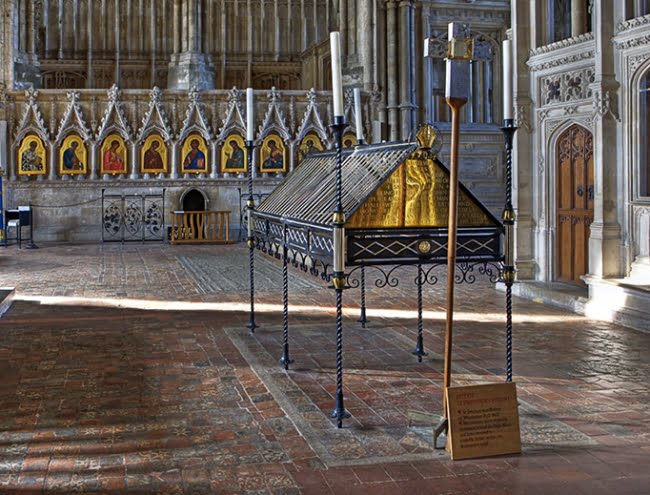
On a recent road-tripping holiday with my family, we immersed ourselves in Howard Pyle’s land of fancy in the Merry Adventures of Robin Hood. In the stories we caught a glimpse of a merry medieval England, but another thing we got a sense of was a continual reference to the intercession of the saints. There were favorite saints of the time, like St. Dunstan and St. Aelfrida and it made my husband and I want focus even more on saints and their feast in our family lives.
I want my children to grow up knowing about things like St. Swithin’s day, which is July 15, and on that day you say this rhyme:
St. Swithin’s day if thou dost rain
For forty days it will remain
St. Swithin’s day if thou be fair
For forty days ’twill rain nae mair.
Perhaps in Wales it often happened that St. Swithen’s day was a predictor of weather for the rest of the summer, and it is also reminiscent of our American tradition of Groundhogs day on February 2. But a keen observer of the Roman liturgical calendar will remember that Groundhogs day falls on Candlemas Day (also known as the Presentation of Our Lord), and with that day comes the Scottish Poem:
If Candlemas Day be dry and fair,
Half the winter’s to come and mair.
If Candlemas Day be wet and foul,
Half o’ winter’s gane at Yule.
While it is a little silly to expect that the weather on one day every year predicts the weather for the following days, the sacramental sense that these rhymes embody is one that I would like to recover. St. Swithin was a Saxon saint canonized by popular acclaim when people began to seek his intercession after his death, and has been honored as a saint since the 9th century. He is not even on the liturgical calendar, but the traditional rhyme remembering his shows a deep Catholic sensibility. And this is a sensibility we can form in ourselves by marking the feast days of the year.
I have my favorite saints that I go to for help, such as St. Anthony for anything that is lost, St. Jude when my baby did not sleep for a month (helpless cause), and now I often turn to Sts. Louis and Zélie Martin, the parents of St. Thérèse of Lisieux to intercede for me in my family life.
We have a set of beautiful volumes called The Liturgical Year by Dom Prosper Guéranger in the 19th century, which focuses on the saint of the day and is prayerfully instructive in the lives of the saints. Through Dom Gueranger we have learned about St. Vitus, whose symbol is a cock, who is very helpful in interceding for people to wake up and if you need to wake up at a certain time, simply ask for his intercession as well. Though St. Vitus is more well known as an intercessor for those with epilepsy. He one of the fourteen holy helpers, who we have been slowly seeking the intercession of as we incorporate the liturgical year and the lives of the saints more and more into our lives.
I would like our year to be marked not just by dates and the change in seasons, but by the names of days. Instead of the Feast of the Archangels, I would like to say Michaelmas Day, and perhaps eat some blackberries to mark the occasion. When it comes to liturgical eating, the seasonal foods are most often part of the traditional cuisine. Martinmas Day (St. Martin de Tours on November 11) is the traditional day to eat goose, perhaps after you have raised them from spring until autumn. Mardi Gras and Lady Day (Annunciation) both occur in the later winter when the crops are not fresh, so waffles and crepes are the main cuisine made from the flour of the previous autumn.
In our family home we have taken to celebrating feasts in our own traditional yet liturgical ways. The Beheading of St. John the Baptist seems like an appropriate day to harvest a cabbage and eat in a cool late summer salad. I use blueberries in from our summer preserving in baked treats to mark feasts of Our Lady throughout the year. We have poems we read on particular feast days, such as Lepanto by G.K. Chesterton for Our Lady of Victory (Our Lady of the Rosary) on October 7. St. Lucy’s day on December 13 is our day to put up our Christmas lights since her name literally means “light.”
I want my children to be familiar with these traditional rhymes and practices, and to feel a community with the saints that have come before us. We in the Church Militant depend upon the Church triumphant. And while St. Barnabas day (June 11) is a little late to first mow the grass and to keep its height within our city ordinances (“St. Barnabas, mow your first grass”), we can still ponder the other rhyme when St. Barnabas Day was the longest of the year before the calendar change: “Barnaby bright, all day and no night.”*
[Source:- Susana Spencer]




